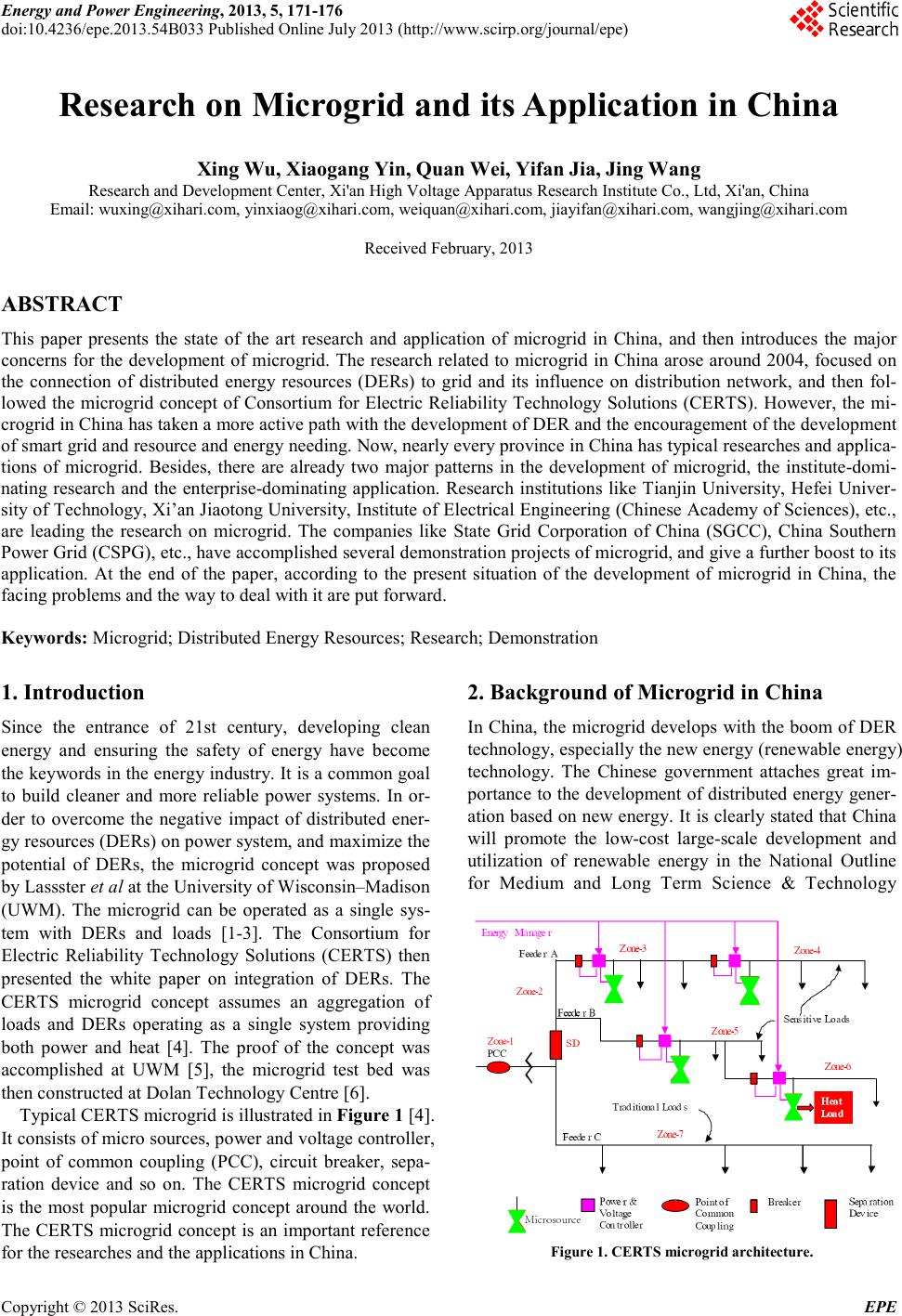 Energy and Power E ngineering, 2013, 5, 171-176 doi:10.4236/epe.2013.54B033 Published Online July 2013 (http://www.scirp . org/journal/epe) Copyright © 2013 SciR es. EPE Research on Microgrid and its Application in China Xing Wu, Xiaogang Yin, Quan Wei, Yifan Jia, Jing Wang Research and Development Cent er, Xi'an Hi gh Volt age Apparatus R esearch Institut e Co., Ltd, X i'an, China Email: wuxing@xihari.com, yinxiaog@xihari.com, weiquan@xihari.com, jiayifan@xihari.com, wangjing@xihari.com Received February, 2013 ABSTRACT This paper presents the state of the art research and application of microgrid in China, and then introduces the major concerns for the development of microgrid. The research related to microgrid in China arose around 2004, focused on the connection of distributed energy resources (DERs) to grid and its influence on distribution network, and then fol- lowed the micro grid co ncept of Consortium for Electric Reliability Technology Solutions (CERTS). However, the mi- cro gri d in China has taken a more active path with the development of DER and the encouragement of t he d eve lo p ment of smart grid and resource and energy needing. Now, nearly every province in China has typical researches and applica- tions of microgrid. Besides, there are already two major patterns in the development of microgrid, the institute-domi- nating research and the enterprise-dominating application. Research institutions like Tianjin University, Hefei Univer- sity of Technology, Xi’an J iaoto ng University, Ins titute of Electrical Engineering (Chinese Academy of Sciences), etc., are leading the research on microgrid. The companies like State Grid Corporation of China (SGCC), China Southern Power Grid (CSPG), etc., have accomplished several demonstration projects of microgrid, and give a further boost to its application. At the end of the paper, according to the present situation of the development of microgrid in China, the facing problems a nd the way to d e a l with it are put forward. Keywords: Microgrid; Distri buted Energy Resources; Research; Demonstration 1. Introduction Since the entrance of 21st century, developing clean energy and ensuring the safety of energy have become the ke ywords in the energy industry. It is a common goal to build cleaner and more reliable power systems. In or- der to overcome the negative impact of distributed ener- gy resources (DERs) on power system, and maximize the potential of DERs, the microgrid concept was proposed by Lassst er et al at the Univer sit y of Wisco nsin–Madison (UWM). The microgrid can be operated as a single sys- tem with DERs and loads [1-3]. The Consortium for Electric Reliability Technology Solutions (CERTS) then presented the white paper on integration of DERs. The CERTS microgrid concept assumes an aggregation of loads and DERs operating as a single system providing both power and heat [4]. The proof of the concept was accomplished at UWM [5], the microgrid test bed was then constructed at Dolan Technology Centre [6]. Typ ical CERTS microgrid is illustrated in F igure 1 [4]. It consists o f micr o sourc es, p o wer and volta ge contro ller, point of common coupling (PCC), circuit breaker, sepa- ration device and so on. The CERTS microgrid concept is the most popular microgrid concept around the world. The CERTS microgrid concept is an important reference for the researches and the appl ic at ions in China. 2. Background of Microgrid in China In China, the microgrid develops with the boom of DER technology, especially the new energy (renewable energy) technology. The Chinese government attaches great im- portance to the develop ment o f distributed energy gener- ation based on new ener gy. It is clearly stated that China will promote the low-cost large-scale development and utilization of renewable energy in the National Outline for Medium and Long Term Science & Technology Figure 1. C ERTS micro grid arch itecture.  X. WU ET AL. Copyright © 2013 SciR es. EPE Development (2006-2020). The National Outl i ne fo r 12th Five-Year Science and Technology Development also put forwards a vision for the development of the new energy technology. The latest released Special Planning of 12th Five-Year Plan on Smart Grid Major Science & Technology Industrialization Projects emphasizes the importance to break through the technology of large- scale intermittent new energy and its storage. Chinese government issued Renewable Energy Law of the People's Republic of China, and medium & long-term Renewable Energy Development Plan to further accele- rate the development of DER. With the support of the national policies mentioned above, the amount of in- vestment in renewable energy in China has reached $51billion in 2011, the total installed capacity of wind power has exceeded 62 GW, and newly installed capacity of solar power has increased to 2.2 GW. The develop- ment of DER technology based on renewable energy in China has been an inevita ble trend. Meanwhile, the research and application of micro-grid in China also continues to heat up. The microgrid in China started by following others, however, it takes a more active way with the support of national policies on DER. Within less than one decade, there are already two developing patterns of microgrid in China, the insti- tute-dominating research and enterprise-dominating ap- plication. With financial support of National Basic Re- search Program (973 Program), National High Technol- ogy Development Program (863 Program), National Natural Science Foundation of China (NSFC), etc., the research of microgrid in China includes various aspects of the microgrid technology. At the same time, the state-owned enterprises and the private enterprises in- crease their investment in the application of DER and microgrid, and nearly every province in China has al- ready had typical DER and microgrid applications. 3. Research on Microgrid The research of microgrid in China began around 2004. It is carried out in accordance with the CERTS microgrid conc ept , foc usin g on DE Rs i nter co nnecti ng with t he bul k power system and their influence on the power network. Now, the research in China covered the key technical issues of microgrid, including: (1) the planning and de- sign of microgrid (including DER)[7-12]; (2)operating characteristics of micro sources [13-15]; (3) microgrid operation and its energy management (including energy storage technology)[16-19]; (4) interconnection of mi- crogrid to the bulk power system[20-22]; (5)island mode of microgrid [23-25]; (6) protection of microgrid [26-28], and so on. Research institutions like Tianjin University, Hefei University of Technology, Xi’an Jiaotong University, Institute of Electrical Engineering (Chinese Academy of Sciences), etc., are leading the research on microgrid. Scholars in Tianjin University started their research from the perspective of planning and design of power system. With the financial support of 973 Program and 863 Program, they carried out research on the planning and design of the microgrid and DERs, the operation, control and protection of the microgrid and the distribu- tion network with DERs. They have built a small micro- grid experimental system and an integrated microgrid system [29]. The small microgrid experimental system is illustrated in Fig ure 2. T his is single -phase 230 V, 50 Hz system. It is composed of energy storage system, photo- voltaic (PV ) simulator, wind po wer simulator and r elated control systems. The microgrid central controller (MCC) is used for the energy management. The system can be operated at two steady-state operation modes (intercon- nection and island), and two transient-state operation modes (transition between interconnection mode and island mode). Hefei Universit y of Technology developed a microgrid system with multi-energy generators through collabora- tive research with the University of New Brunswick, Canada [30, 31]. They carried out research on the opti- mization of the design, control and scheduling strategies of the microgrid. The microgrid structure is shown Fig- ure 3. T he syst em consis ts of a 1 0 kW si ngle-phase and a 30 kVA three-phase PV generators, two 30 kW three- phase wind generation si mul ator s , 5 kW fuel cell, 300 Ah battery bank, 1800F ultra-capacitor bank and two sets of 15kW co nventional ge nerators used to simulate the small hydro and small fossil generators, various loads (resistors, capacitor, inductors, AC and DC motors and other elec- tronic loads). This microgrid has two-layer hierarchical control system, the local controllers and the central con- troller. An energy management system that conforms to the IEC61970 standards was developed. The research on microgrid in Xi'an Jiaot ong University started with the application of power electronics tech- nology. With the financial support of 863 program and Figure 2 . The s mall microgri d ex perimental sy stem in Ti an- jin University. 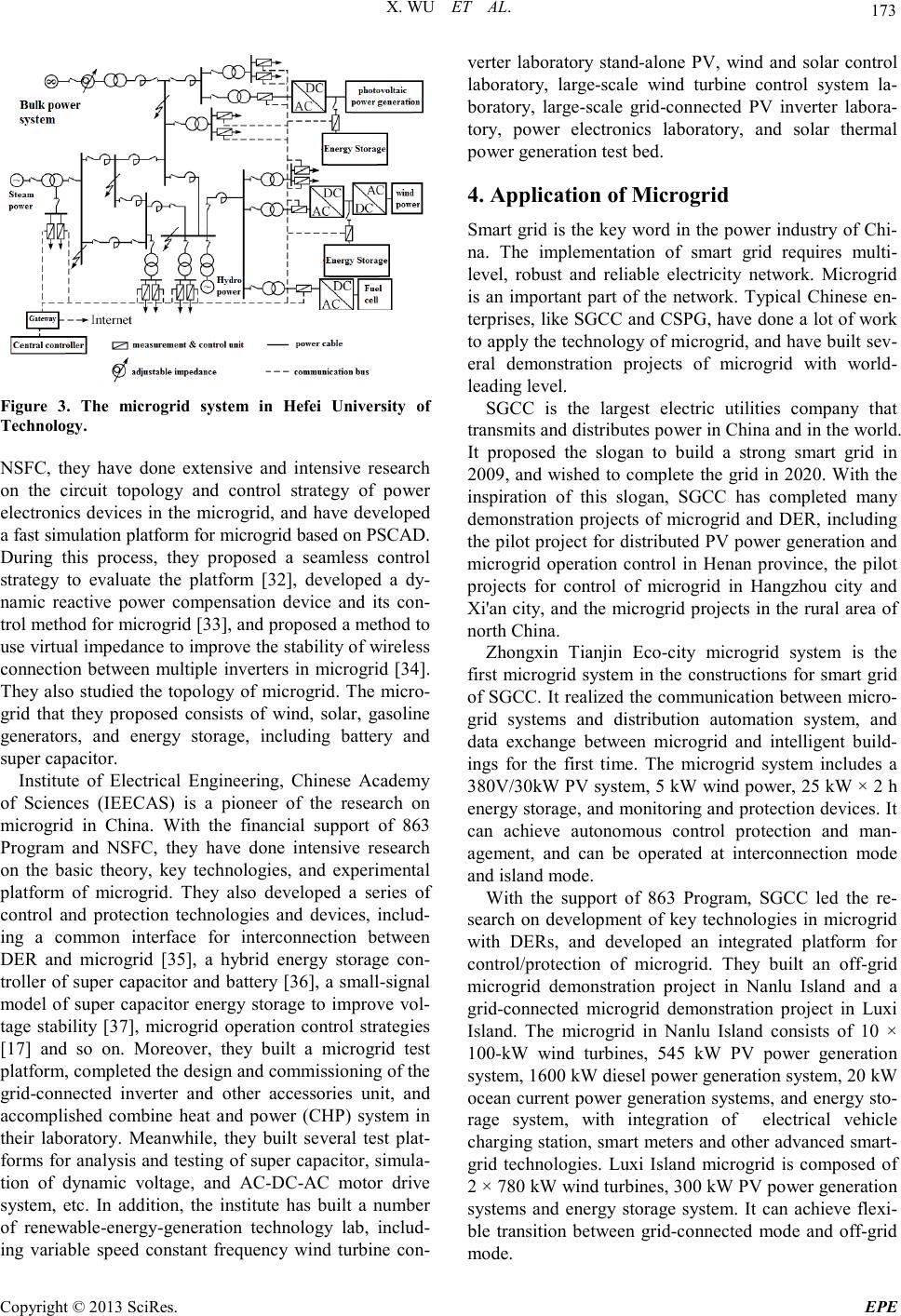 X. WU ET AL. Copyright © 2013 SciR es. EPE Figure 3. The microgrid system in Hefei University of Technology. NSFC, they have done extensive and intensive research on the circuit topology and control strategy of power electronics devices in the microgrid, and have developed a fast simula tion platform for microgrid based on PSCAD. During this process, they proposed a seamless control strategy to evaluate the platform [32], developed a dy- nami c reactive power compensation device and its con- trol method for microgrid [33], and proposed a method to use virt ual impedance to improve the stabilit y of wireless connection between multiple inverters in microgrid [34]. They also studied the topology of microgrid. The micro- grid that they proposed consists of wind, solar, gasoline generators, and energy storage, including battery and super capacitor. Institute of Electrical Engineering, Chinese Academy of Sciences (IEECAS) is a pioneer of the research on microgrid in China. With the fina ncial support of 863 Program and NSFC, they have done intensive research on the basic theory, key technologies, and experimental platform of microgrid. They also developed a series of control and protection technologies and devices, includ- ing a common interface for interconnection between DER and microgrid [35], a hybrid energy storage con- troller of super capacitor and battery [36], a small-signal model of super capacitor energy storage to improve vol- tage stability [37], microgrid operation control strategies [17] and so on. Moreover, they built a microgrid test platfor m, completed the design and commissionin g o f the grid-connected inverter and other accessories unit, and accomplished combine heat and power (CHP) system in their laboratory. Meanwhile, they built several test plat- for ms for analysis and testing of super capacitor, simula- tion of dynamic voltage, and AC-DC-AC motor drive system, etc. In addition, the institute has built a number of renewable-energy-generation technology lab, includ- ing variable speed constant frequency wind turbine con- verter laboratory stand-alone PV, wind and solar control laboratory, large-scale wind turbine control system la- boratory, large-scale grid-connected PV inverter labora- tory, power electronics laboratory, and solar thermal power generation test bed. 4. Application of Microgri d Smart grid is the key word in the powe r ind ustr y of Chi- na. The implementation of smart grid requires multi- level, robust and reliable electricity network. Microgrid is an important part of the network. Typical Chinese en- terprises, like SGC C and CSP G, have done a lot of work to apply the technology of microgrid, and have built sev- eral demonstration projects of microgrid with world- leading le vel. SGCC is the largest electric utilities company that transmits and d istrib utes po we r in C hi na and i n t he wor ld . It proposed the slogan to build a strong smart grid in 2009, and wished to complete the grid in 2020. With the inspiration of this slogan, SGCC has completed many demonstration projects of microgrid and DER, including the pilot pr oject for distributed PV power ge neratio n and microgrid operation control in Henan province, the pilot projects for control of microgrid in Hangzhou city and Xi'an city, and the microgrid projects in the rural area of north China. Zhongxin Tianjin Eco-city microgrid system is the first microgrid system in the constructions for smart grid of SGCC. It realized the communication between micro- grid systems and distribution automation system, and data exchange between microgrid and intelligent build- ings for the first time. The microgrid system includes a 380V/30kW PV system, 5 kW wind power, 25 kW × 2 h energy storage, and monitoring and pr otection devices. It can achieve autonomous control protection and man- agement, and can be operated at interconnection mode and island mode. With the support of 863 Program, SGCC led the re- search on development of key technologies in microgrid with DERs, and developed an integrated platform for control/protection of microgrid. They built an off-grid microgrid demonstration project in Nanlu Island and a grid-connected microgrid demonstration project in Luxi Island. The microgrid in Nanlu Island consists of 10 × 100-kW wind turbines, 545 kW PV power generation system, 1600 kW diese l p o we r ge ner a tio n s ystem, 2 0 kW ocean current power generation systems, and energy sto- rage system, with integration of electrical vehicle charging station, smart meters and other advanced smart- grid technologies. Luxi Island microgrid is composed of 2 × 780 kW wind turbines, 300 kW PV power generation systems and energy storage system. It can achieve flexi- ble transition between grid-connected mode and off-grid mode. 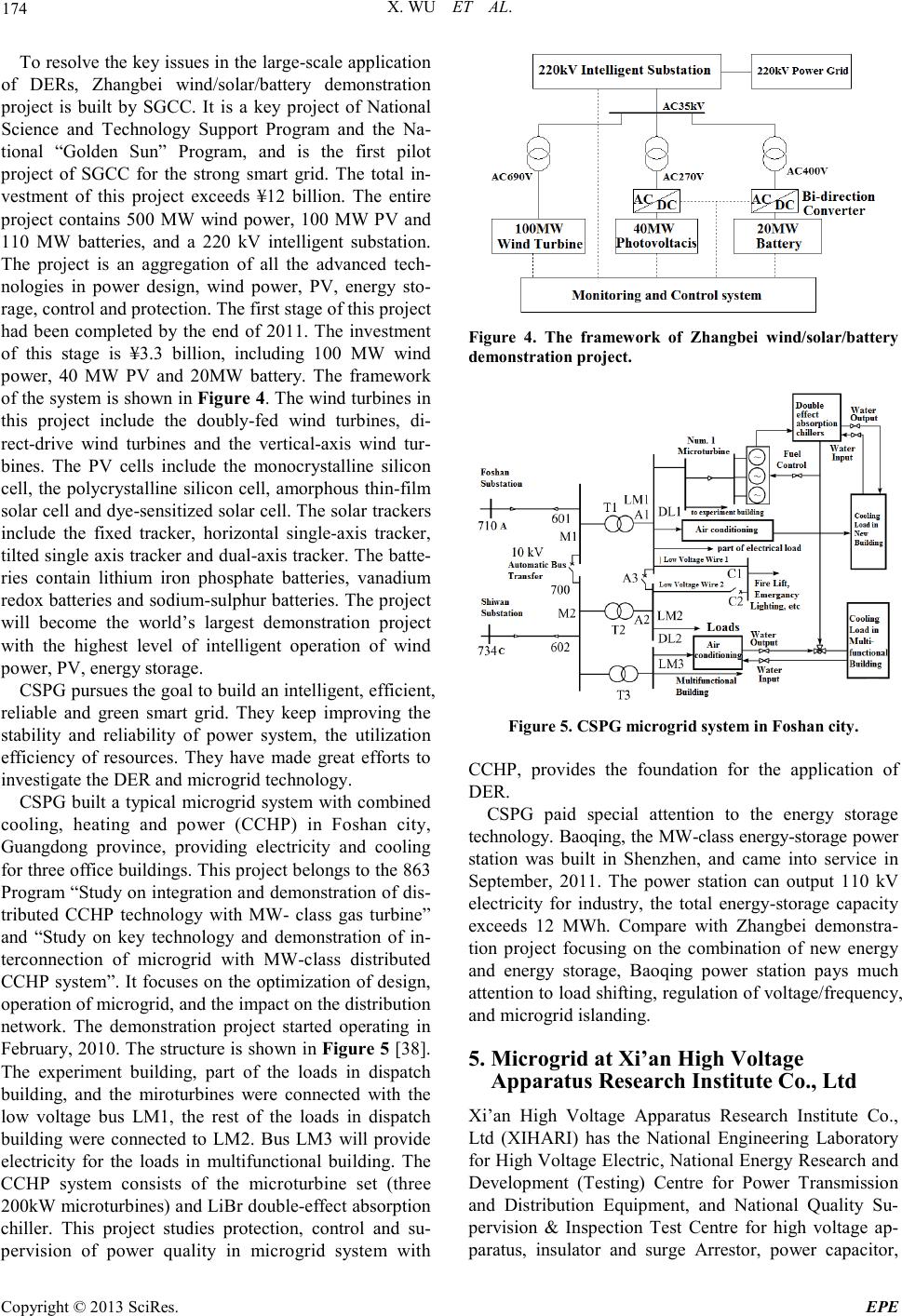 X. WU ET AL. Copyright © 2013 SciR es. EPE To r esolve the key i ssues i n the large -scale application of DERs, Zhangbei wind/solar/ba tte r y demonstration project is built by SGCC. It is a key project of National Science and Technology Support Program and the Na- tional “Golden Sun” Program, and is the first pilot project of SGCC for the strong smart grid. The total in- vestment of this project exceeds ¥12 billion. The entire project contains 500 MW wind power, 100 MW PV and 110 MW b a tte r ies, and a 220 kV intelligent substation. The project is an aggregation of all the advanced tech- nologies in power design, wind power, PV, energy sto- rage, control and protection. The first stage o f this proje c t had been completed by the end of 2011. The investment of this stage is ¥3.3 billion, including 100 MW wind power, 40 MW PV and 20MW battery. The framework of the system is sho wn in Fig ure 4. T he wind tur bine s i n this project include the doubly-fed wind turbines, di- rect-drive wind turbines and the vertical-axis wind tur- bines. The PV cells include the monocrystalline silicon cell, the polycrystalline silicon cell, a morp hous thin-film solar cell and dye-sensi tized solar cell. The solar trackers include the fixed tracker, horizontal single-axis tracker, tilted single a xis tracker and d ual-axis tracker. The batte- ries contain lithium iron phosphate batteries, vanadium redox batteries and sodium-sulphur batteries. The proj ect will become the world’s largest demonstration project with the highest level of intelligent operation of wind power, PV, energy storage. CSPG pursues the goa l to build an intelligent, efficient, reliable and green smart grid. They keep improving the stability and reliability of power system, the utilization efficiency of resources. They have made great efforts to inves tigate t he DER and microgri d tec hnology. CSPG built a typical microgrid system with combined cooling, heating and power (CCHP) in Foshan city, Guangdong province, providing electricity and cooling for three office buildings. This project be longs to the 863 Program “Stud y on i ntegration and demonstration of dis- tributed CCHP technology with MW- class gas turbine” and “Study on key technology and demonstratio n of in- terconnect ion of microgrid with MW-class distributed CCHP system”. It focuses on the optimization of design, operation of microgrid, and the i mpact on the distribution network. The demonstration project started operating in February, 2010. The str uctur e is sho wn i n Figure 5 [38]. The experiment building, part of the loads in dispatch building, and the miroturbines were connected with the low voltage bus LM1, the rest of the loads in dispatch building were connected to LM2. Bus LM3 will provide electricity for the loads in multifuncti onal building. The CCHP system consists of the microturbine set (three 200kW microturbines) and LiBr double-effect absorption chiller. This project studies protection, control and su- pervision of power quality in microgrid system with Figure 4. The framework of Zhangbei wind/solar/battery demonstration project. Figure 5 . CSPG microgrid syste m i n Foshan city . CCHP, provides the foundation for the application of DER. CSPG paid special attention to the energy storage technology. Baoqing, the MW-class energy-storage power station was built in Shenzhen, and came into service in September, 2011. The power station can output 110 kV electricit y for industry, the total energy-storage capacity exceeds 12 MWh. Compare with Zhangbei demonstra- tion project focusing on the combination of new energy and energy storage, Baoqing power station pays much attention to lo ad shifting, r egulation of voltage/frequency, and microgrid isla nding. 5. Microgrid at Xi’an High Voltage Apparatus Research Institute Co., Ltd Xi’an High Voltage Apparatus Research Institute Co., Ltd (XIHARI) has the National Engineering Laboratory for High Voltage Electric, National Energ y Research and Development (Testing) Centre for Power Transmission and Distribution Equipment, and National Quality Su- pervision & Inspection Test Centre for high voltage ap- paratus, insulator and surge Arrestor, power capacitor, 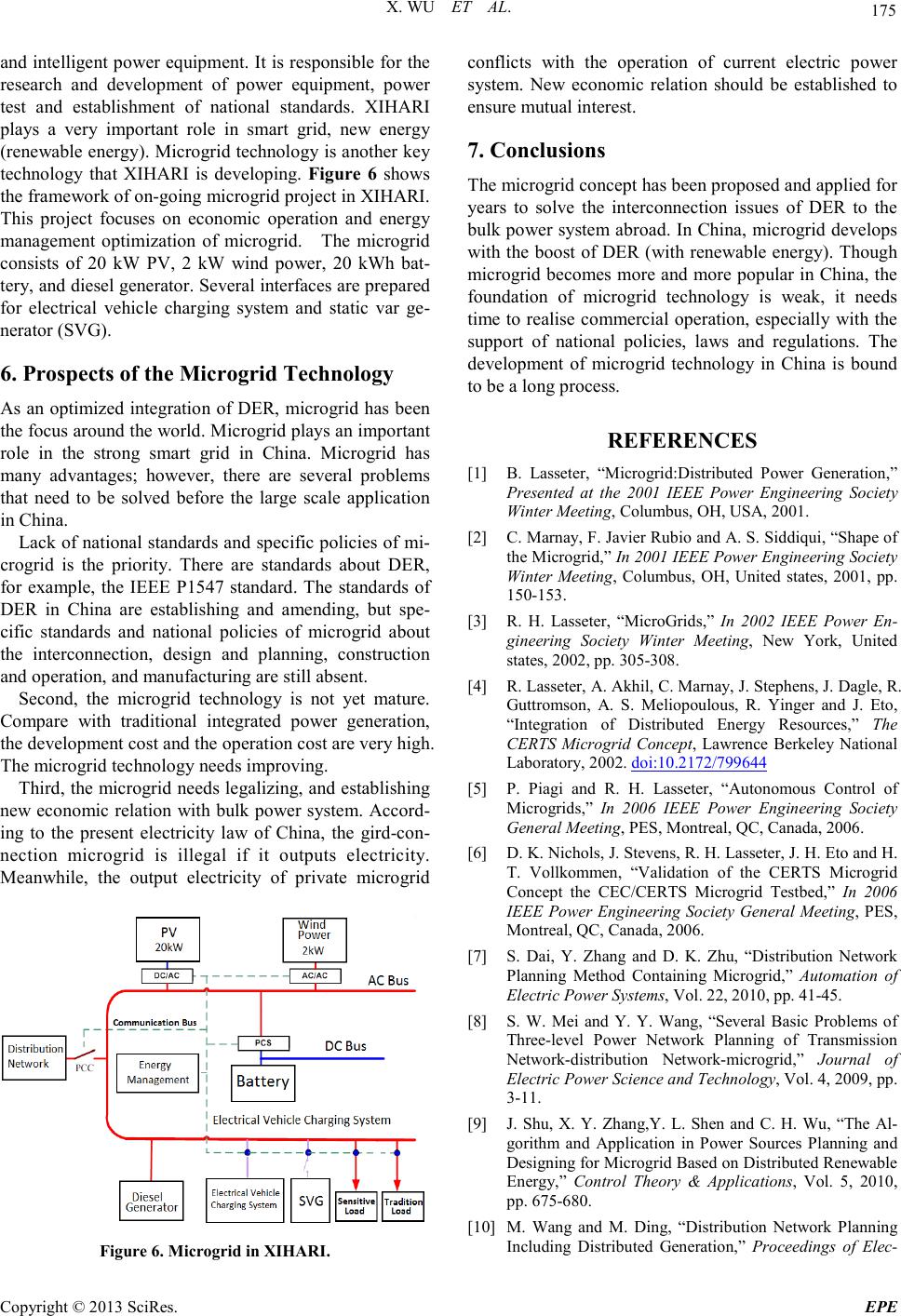 X. WU ET AL. Copyright © 2013 SciR es. EPE and intelligent p ower equipme nt. It is responsible for the research and development of power equipment, power test and establishment of national standards. XIHARI plays a very important role in smart grid, new energy (renewable energy). Microgrid technology is a nother ke y technology that XIHARI is developing. Figure 6 shows the framework of on-going mi cr o gri d pr oj e ct in XI HARI . This project focuses on economic operation and energy management o p timization of microgrid. The microgrid consists of 20 kW PV, 2 kW wind power, 20 kWh bat- tery, and d iesel generator. Several interfaces are prepared for electrical vehicle charging system and static var ge- nerator (SVG). 6. Prospects of the Microgrid Technology As an optimized integration of DER, microgrid has been the fo c us ar o und the wor ld . Micr o gr id p la ys a n i mportant role in the strong smart grid in China. Microgrid has many advantages; however, there are several problems that need to be solved before the large scale application in China. Lack of national standards and specific policies of mi- crogrid is the priority. There are standards about DER, for example, the IEEE P1547 standard. The standards of DER in China are establishing and amending, but spe- cific standards and national policies of microgrid about the interconnection, design and planning, construction and operation, and manufacturing are still absent. Second, the microgrid technology is not yet mature. Compare with traditional integrated power generation, the development cost and the operation cost are very high. The microgrid technology needs improving. Third, the microgrid needs legalizing, and establishing new economic relation with bulk power system. Accord- ing to the present electricity law of China, the gird-co n- nection microgrid is illegal if it outputs electricity. Meanwhile, the output electricity of private microgrid Figure 6 . Microgri d in XIHARI. conflicts with the operation of current electric power system. New economic relation should be established to ensure mutual interest. 7. Conclusions The microgrid concept has been proposed and applied for years to solve the interconnection issues of DER to the bulk p ower s ystem abr oad. I n China, microgri d develops with the boost of DER (with renewable energy). Though microgrid becomes more and more popular in China, the foundation of microgrid technology is weak, it needs time to realise commercial operation, especially with the support of national policies, laws and regulations. The development of microgrid technology in China is bound to be a long process. REFERENCES [1] B. Lasseter, “Microgrid:Distributed Power Generation,” Presented at the 2001 IEEE Power Engineering Society Winter Meeting, Columbus, OH, USA, 2001. [2] C. Marnay, F. Javier Rubio and A. S. Siddiqui, “Shape of the Microgrid,” In 2001 IEEE Power Engineering Soci ety Winter Meetin g, Columbus, OH, United states, 2001, pp. 150-153. [3] R. H. Lasseter, “MicroGrids,” In 2002 IEEE Power En- gineering Society Winter Meeting, New York, United states, 2002, pp. 305-308. [4] R. Lasset er, A. Akhi l, C . Marn ay, J. S teph ens , J. Dagle, R . Guttromson, A. S. Meliopoulous, R. Yinger and J. Eto, “Integration of Distributed Energy Resources,” The CERTS Microgrid Concept, Lawrence Berkeley National Laboratory, 2002. doi:10.2172/799644 [5] P. Piagi and R. H. Lasseter, “Autonomous Control of Microgrids,” In 2006 IEEE Power Engineering Society General Meeting , PES, Montre a l , QC , Canada, 20 06. [6] D. K. Ni chols, J. Stevens, R. H. Lasseter, J. H. Eto an d H. T. Vollkommen, “Validation of the CERTS Microgrid Concept the CEC/CERTS Microgrid Testbed,” In 2006 IEEE Power Engineering Society General Meeting, PES, Montreal, QC, Canada, 2006. [7] S. Dai, Y. Zhang and D. K. Zhu, “Distribution Network Planning Method Containing Microgrid,” Automation of Electric Power S ystems, Vol. 22, 2010, pp. 41-45. [8] S. W. Mei and Y. Y. Wang, “Several Basic Problems of Three-level Power Network Planning of Transmission Network-distribution Network-microgrid,” Journal of Electric P ow er Sci ence and Techn olo gy, Vol. 4, 2009, pp. 3-11. [9] J. Shu, X. Y. Zhang,Y. L. Shen and C. H. Wu, “The Al- gorithm and Application in Power Sources Planning and Designing for Microgrid Based on Distributed R enewabl e Energy,” Control Theory & Applications, Vol. 5, 2010, pp. 675-680. [10] M. Wang and M. Ding, “Distribution Network Planning Including Distributed Generation,” Proceedings of Elec- 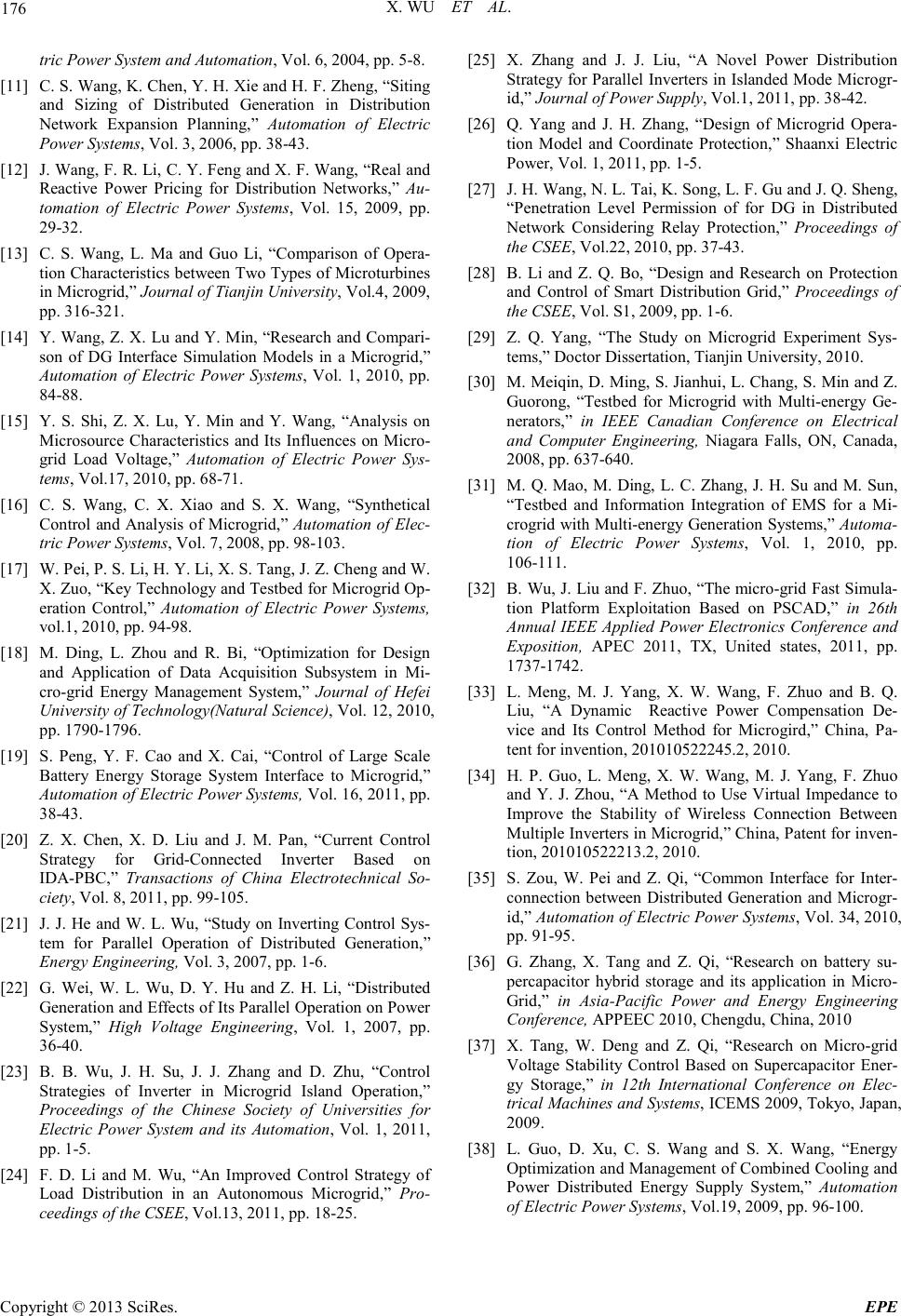 X. WU ET AL. Copyright © 2013 SciR es. EPE tric Power System and Automation, Vol. 6, 2004, p p. 5-8. [11] C. S. Wang, K. Chen, Y. H. Xie and H. F . Zheng, “Siting and Sizing of Distributed Generation in Distribution Network Expansion Planning,” Automation of Electric Power Systems, Vol. 3, 2006, pp. 38-43. [12] J. Wang, F. R. Li, C. Y. Feng and X. F . Wang, “Real an d Reactive Power Pricing for Distribution Networks,” Au- tomation of Electric Power Systems, Vol. 15, 2009, pp. 29-32. [13] C. S. Wang, L. Ma and Guo Li, “Comparison of Opera- tion Characteristics between Two Types of Micro turbines in Microgrid,” Journal of Tianjin University, Vol.4, 2009, pp. 316-321. [14] Y. Wang, Z. X. Lu and Y. Min, “Resear ch and Co mpari- son of DG Interface Simulation Models in a Microgrid,” Automation of Electric Power Systems, Vol. 1, 2010, pp. 84-88. [15] Y. S. Shi, Z. X. Lu, Y. Min and Y. Wang, “Analysis on Microsource Characteristics and Its Influences on Micro- grid Load Voltage,” Automation of Electric Power Sys- tems, Vol.17, 2010, pp. 68-71. [16] C. S. Wang, C. X. Xiao and S. X. Wang, “Synthetical Control and Analysis of Microgrid,” Automation of Elec- tric Power Systems, Vol. 7, 2008, pp. 98-103. [17] W. Pei, P. S. Li, H. Y. Li, X. S. Tang, J. Z. Cheng and W. X. Zuo, “Key Technology and Testbed for Microgrid Op- eration Control,” Automation of Electric Power Systems, vol.1, 2010, pp. 94-98. [18] M. Ding, L. Zhou and R. Bi, “Optimization for Design and Application of Data Acquisition Subsystem in Mi- cro-grid Energy Management System,” Journal of Hefei Universit y of Techn ology(Nat ural Sci ence), Vol. 12, 2010, pp. 1790 -1796. [19] S. Peng, Y. F. Cao and X. Cai, “Control of Large Scale Battery Energy Storage System Interface to Microgrid,” Automation of Electric Power Systems, Vol. 16, 2011, pp. 38-43. [20] Z. X. Chen, X. D. Liu and J. M. Pan, “Current Control Strategy for Grid-Connected Inverter Based on IDA-PBC,” Transactions of China Electrotechnical So- ciety, Vol. 8, 2011, pp. 99-105. [21] J. J. He and W. L. Wu, “Study on Inverting Control Sys- tem for Parallel Operation of Distributed Generation,” Energy Engineering, Vol. 3, 2007, pp. 1-6. [22] G. Wei, W. L. Wu, D. Y. Hu and Z. H. Li, “Distributed Generati on and Effects o f Its Parallel O peration on Power System,” High Voltage Engineering, Vol. 1, 2007, pp. 36-40. [23] B. B. Wu, J. H. Su, J. J. Zhang and D. Zhu, “Control Strategies of Inverter in Microgrid Island Operation,” Proceedings of the Chinese Society of Universities for Electric Power System and its Automation, Vol. 1, 2011, pp. 1-5. [24] F. D. Li and M. Wu, “An Improved Control Strategy of Load Distribution in an Autonomous Microgrid,” Pro- ceedings of the CSEE, Vol.13, 2011, pp. 18-25. [25] X. Zhang and J. J. Liu, “A Novel Power Distribution Strateg y for P arallel In verters i n Island ed Mode Microgr- id,” Journal of Power Supply, Vol.1, 2011, pp. 38-42. [26] Q. Yang and J. H. Zhang, “Design of Microgrid Opera- tion Model and Coordinate Protection,” Shaanxi Electric Power, Vol. 1, 2011, pp. 1-5. [27] J. H. Wang, N. L. Tai, K. Song, L. F. Gu and J. Q. Sheng, “Penetration Level Permission of for DG in Distributed Network Considering Relay Protection,” Proceedings of the CSEE, Vol.22, 2010, pp. 37-43. [28] B. Li and Z. Q. Bo, “Design and Research on Protection and Control of Smart Distribution Grid,” Proceedings of the CSEE, Vol. S1, 2009, pp. 1-6. [29] Z. Q. Yang, “The Study on Microgrid Experiment Sys- tems,” Doctor Dissertation, Tianjin University, 2010. [30] M. Meiqin, D. Ming, S. Jianhui, L. Chang, S. Min and Z. Guorong, “Testbed for Microgrid with Multi-energy Ge- nerators,” in IEEE Canadian Conference on Electrical and Computer Engineering, Niagara Falls, ON, Canada, 2008, pp . 637-640. [31] M. Q. Mao, M. Ding, L. C. Zhang, J. H. Su and M. Sun, “Testbed and Information Integration of EMS for a Mi- crogrid with Multi-energy Generatio n Systems,” Automa- tion of Electric Power Systems, Vol. 1, 2010, pp. 106-111. [32] B. Wu, J . Liu and F. Z huo, “The micro-grid Fast Simula- tion Platform Exploitation Based on PSCAD,” in 26th Annual IEEE Applied Power Electronics Conference and Exposition, APEC 2011, TX, United states, 2011, pp. 1737-1742. [33] L. Meng, M. J. Yang, X. W. Wang, F. Zhuo and B. Q. Liu, “A Dynamic Reactive Power Compensation De- vice and Its Control Method for Microgird,” China, Pa- tent for invention, 201010522245.2, 2010. [34] H. P. Guo, L. Meng, X. W. Wang, M. J. Yang, F. Zhuo and Y. J. Zhou, “A Method to Use Virtual Impedance to Improve the Stability of Wireless Connection Between Multiple Inverters i n Microgrid,” China, Patent for inven- tion, 201 01 052221 3.2, 20 10. [35] S. Zou, W. Pei and Z. Qi, “Common Interface for Inter- connection between Distributed Generation and Microgr- id,” Automation of Electric Power Systems, Vol. 34, 2010, pp. 91-95. [36] G. Zhang, X. Tang and Z. Qi, “Research on battery su- percapacitor hybrid storage and its application in Micro- Grid,” in Asia-Pacific Power and Energy Engineering Conf erence, APPEEC 2010, Chengdu, China, 2010 [37] X. Tang, W. Deng and Z. Qi, “Research on Micro-grid Voltage Stability Control Based on Supercapacitor Ener- gy Storage,” in 12th International Conference on Elec- trical Machines and Systems, ICEMS 2009, Tokyo, Japan, 2009. [38] L. Guo, D. Xu, C. S. Wang and S. X. Wang, “Energy Optimization and Management of Combined Cooling and Power Distributed Energy Supply System,” Automation of Electric Power Systems, Vol.19, 2009, pp. 96-100.
|